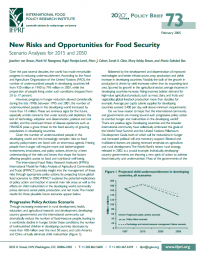
New Risks and Opportunities for Food Security: Scenario for 2015 and 2050

Over the past several decades, the world has made remarkable progress in reducing undernourishment. According to the Food and Agriculture Organization of the United Nations (FAO), the number of undernourished people in developing countries fell from 920 million in 1980 to 798 million in 2001, while the proportion of people living under such conditions dropped from 28 to 17 percent.
However, progress in hunger reduction slowed considerably during the late 1990s: between 1995 and 2001, the number of undernourished people in the developing world increased by more than 18 million.These are ominous signs for the future, especially amidst concerns that water scarcity, soil depletion, the lack of technology adoption and dissemination, political and civil conflict, and the continued threat of disease epidemics such as HIV/AIDS pose a grave threat to the food security of growing populations in developing countries.
Given the number of undernourished people in the developing world and the increasingly complex risks to food security, policymakers are faced with an enormous agenda. Freeing people from hunger will require more and better-targeted investments, innovations, and policy actions, driven by a keen understanding of the risks and forces that shape the factors affecting people’s access to food and nutritional well being.
- Issues:
- Health, Global and Domestic Governance, Natural Resources
- Region:
- Global
- Year Published:
- 2005
- Authors:
- Mark W. Rosegrant, Sarah A. Cline, Joachim von Braun, Rajul Pandya-Lorch, Marc J. Cohen, Mary Ashby Brown, María Soledad Bos
- Institution:
- International Food Policy Research Institute (IFPRI)

